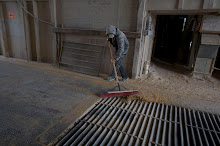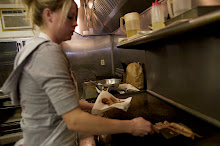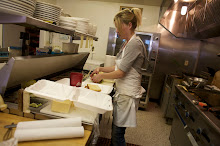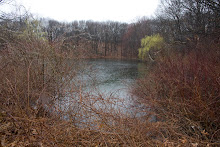OKAY, HERE IT IS. Only the first 2 photos are in the body of the paper. She asked me to include all of the photos for her, so you're getting them, too. The others are talked about in the footnotes.
What is a documentary photograph? Can a single picture constitute a document, or does a picture need a thousand words? Can we comment on social injustice without linguistic and cultural contextualization? For Eugene Richards the answer is yes. For Allan Sekula the answer is no. This paper will begin to compare these two contemporary photographers and their paths to what John Grierson called “the creative treatment of actuality.”[1]
Photo I Eugene Richards
It is a snowy day and a dead deer lays in the right foreground in what appears to be an endless prairie, eviscerated and bloody, legs akimbo, head intact, dead eyes seeming to look back toward an abandoned farmhouse barely visible over the crest of the hill, and possible safety. Taken in color and low to the ground, it is the angle the deer would have seen in life. It is a bleak world, one that needs no words for Americans to piece together a story that we know all too well about rural American life.[2]
Richards, who was a student of Minor White at MIT, calls himself a “social realist” and works in the modernist tradition. He opens the door to the world of his subjects, presenting us with unmediated narratives that are probably fairly close to what he is experiencing at the moment.[3] His written commentaries, where they exist, adhere to the experience at hand, and although we can interpolate his social politics based on his subject matter, he does not emphasize this, or any other motivation, other than “becoming obsessed”[4] with what he sees, and following it until he is satisfied that he’s gotten enough to tell the story. Visually, he tells his stories of social dislocation by disrupting the plane, bisecting images, or placing markers for meaning so tightly in the foreground that they become the disfunction he is witnessing.
His powerful photo essays include his first wife’s death, drug addiction, insane asylums, emergency rooms, aging hippy communes, and his home town of Dorchester, MA,[5] as well as the more lyrical, if equally bleak, Blue Room. He has won a Guggenheim, nearly every photojournalism award, and a few more “arty” ones as well. His ability to convey chaos, turmoil or tragic changes that are inherent qualities of many of his subjects is done entirely in the camera. He has numerous books, works with The Nation Institute (a left wing online journal), conducts workshops, publishes his work in books, periodicals and online, and is largely ignored by the academic art world.
Photo II Allan Sekula
Bloody tire tracks in bloody snow crisscross the foreground. The blood is the same color as the roof tiles and the painted window frames of the half-timber middle European farmhouse that dominates the photo. A blue tractor, obviously not American, is dwarfed by farmhouse and blood-soaked snow. The only sign of “life” is a skinned and bloody animal carcass hanging from the raised front forks of the tractor, although it takes a minute to see it and then realize what it is.[6]
While many of Allan Sekula’s images could possibly stand alone, they are not meant to. Working squarely in the postmodern tradition as a Critical Realist,[7] Sekula is driven as much by his politics, his reading of history, and his sense of social justice as by his visual aesthetics. The calm, collected, often scripted images are usually crisply in focus, and except in rare instances, his subjects are posing and facing the camera.[8] He tends to stand apart and at some distance from his subjects, whether people, objects or landscapes, and many of his photos would feel trite[9] if they were not meant to be viewed as parts of sequences or allegories for deeper realities. That distance between what Barthes calls the “operator” and the “spectator,”[10] stands in stark contrast to Richards’ visceral approach and makes contextualization an essential component for Sekula. Referring to the photo with the carcass, he said, “Should I tell you anything more specific about these small glimpses of [East] Germany? Is it important to know that two photographs were taken on opposite sides of the same street...or that the border was a tourist attraction although a nearby Nazi labor camp was unmarked and seemingly unremembered?”[11]
The answer is, of course, yes. It is the only way for us to know that the picture is about the banality of life in a place once pierced by terror, and not about animal rights, for instance.[12]
Sekula’s work, which is almost always shown as installations, is widely acknowledged in art and academic circles as perfect examples of Critical Realism, with Sekula himself considered its foremost living practitioner. He has won a Guggenheim, countless awards, is a beloved teacher at Cal Arts, has numerous books, shows in museums and galleries throughout the world, and is himself the subject of enthusiastic academic inquiry.[13]
What accounts for the difference in how they are received?
From its inception, photography was a medium born to document the immediate.[14] Despite the avant-garde’s desire to push the envelope in new directions, inexpensive cameras were marketed to ordinary people as tools for documenting family life, priming ordinary Americans to think of the documentary as important and truthful.[15] The Family of Man gave further legitimacy to the genre.[16]
Later, as painters were deconstructing the surface, art photographers were struggling with the mechanical relationship between shutter and lens,[17] which led in the 60”s to “a revival of interest in the radical [Marxist] theories and methods of the…avant-guarde.”[18] Documentarians who did not engage in these discussions, or who made a specialty of other people’s misery were accused of exploitation.[19]
Unfortunately, Eugene Richards fell into both categories. Sekula, on the other hand, relished the new forms of inquiry, juxtaposing seemingly benign or banal imagery with strong political critiques.[20] His continued interest in leftist theory, putting into his art ideas that are reflective of his social politics, still make him interesting to others grappling with questions of meaning and context in art-making.
So, is one path better or more valid to “the creative treatment of actuality?” Richards wordlessly commentates on difficult subjects with disturbing candor, achieving a “discordant complexity,”[21] which makes the unstable worlds of his subjects visible to all levels of society —and visibility is often a game changer for the powerless.[22] Whether or not a linguistically, politically driven artist like Allan Sekula—who constructs narratives for educated audiences—can effect change in that way, the significance of his work may lie in how, by rearranging “actualities” in intellectually and visually interesting ways, he advances in his analytical way the same important discussion of the dilemma of the artist’s role as cultural commentator.
[1] First used by John Grierson in a review of “Moana” the first intentional documentary, about Samoa, in 1926. He later elaborated on the term in “First Principles of Documentary:” “We believe that the cinema’s capacity for getting around, for observing and selecting from life itself, can be exploited in a new and vital art form. The studio films largely ignore this possibility of opening up the screen on the real world. They photograph acted stories against artificial backgrounds. Documentary would photograph the living scene and the living story.” quoted from “Imagining Reality: The Faber Book of Documentary,” Faber & Faber, London, 1998. p.97
[2] Richard, Eugene. The Blue Room. Phaedon Press, New York. 2008, p.30. Those pictures were so successful that people in North Dakota felt it portrayed their state unfairly, making it look like the whole state was abandoned.
[3] See “Final chemotherapy treatment, Boston, 1979, included in accompanying photo sheets. This single image of Dorothea is one of the most poignant photos of loss and longing I have ever seen, needing no words.
[4] Richards, Eugene. “The Blue Room.” Slideshow. No date. http://www.foto8.com/movies/EugeneRichards_blue/index.html
[5] See the accompanying photo sheets for this and other photos by Richards and Sekula, some mentioned in the body of this paper some not, for different treatments of the same basic subject. The photo of Richards’ dying wife has no parallel in Sekula’s work.
[6] Sekula, Allan. “Sketches for a New Geography,” in Dismal Science. University of Illinois Press, Normal, IL 1999. p.164.
[7] Although Critical Realism is a philosophic discipline associated with the nexus between science and religion, for artists it also includes a willingness to engage in critical dialogue (from a leftist perspective) around social and political issues that affect people’s economic, social and spiritual well-being.
[8] Two photos worth mentioning in this regard are “Masculine/Feminine Life In The Suburbs 1973” and worth a closer look for the way that Sekula creates subtle commentary. In the Masculine picture, a young man on a patio is sitting on a low chair, legs splayed, bent at the knees, his moustached, goateed face partly obscured by the newspaper he is reading. He is wearing sunglasses and has socks on but no shoes, and there is something vaguely unattractive about him. To his left, on the ground, is a phone on its cradle. In the Feminine photo, a young woman is lying on her back talking on the phone, on what appears to be the same patio. Her two arms are raised seductively to her head, one holding the phone, the other playing with her hair. Her eyes are closed and she is obviously in conversation. The allegorical signposts are everywhere, but to fully understand the critique implicit in these photos, one must also know the title of the book that they are in: Performance Under Working Conditions. Copies of these photos are on the separate photo sheets.
[9] A rare and lyrical exception to this are the four street scenes from Geography Lessons Canadian Notes. MIT Press, Cambridge, MA. 1997. pp.22-23. See attached photo sheet.
[10] Barthes, Roland. Camera Lucida. Hill & Wang, New York. 1980. p.10
[11] Sekula. Op cit. p.174
[12] Speaking in another context, he says, “I wanted to construct works from within concrete life situations, situations within which there was an overt or active clash of interests and representations. Any interest that I had in artifice and constructed dialogue was part of a search for a certain "realism," a realism not of appearances or social facts but of everyday experience in and against the grip of advanced capitalism.” “Photography Against The Grain,” in Dismal Science. University Galleries of Illinois State University. 1999.
P.151 Interestingly, Sekula will often insert sections of photo essays that are taken from others of his books into new works, enhancing the experience that he is always looking at the plight of workers from a global perspective.
[13] Baetens, Jan & van Gelder, Hilde, eds. Critical Realism in Contemporary Art Around Allan Sekula's Photography Leuven University Press, Belgium. 2006
[14] Wall, Jeff. “Marks of Indifference”: Aspects of Photography In, Or As, Conceptual Art.” Jeff Wall: Works and Collected Writings, ed. Michael Newman. Poligrafa Ediciones, Barcelona, 2007. p.341. The essay was first published in 1995.
[15] This has continued up to the present time, becoming more and more accessible, not only through increasingly sophisticated video cameras and recorders, but through the advent of YouTube and other social media, allowing some artists to happily blur the line between popular culture and high art, some to erase the distinction all together, some to continue on in the classical and modernist pursuits of beauty, and some to continue to grapple with art that is meant to be a political and social critique of it all.
[16] Steichen, Edward. The Family of Man. Maco Magazine Corporation, NY. 1955. First mounted at MoMA in 1955, it was meant to show, according to Edward Steichen who created the show, “that the art of photography is a dynamic process of giving form to ideas and of explaining man to man.” Taken from the Introduction
[17] Wall, Jeff. Ibid. “Photography cannot find alternatives to depiction, as could other fine arts. It is in the physical nature of the medium to depict things. In order to participate in the kid of reflexivity made mandatory for modernist art, photography can put into play only its own necessary condition of being a depiction-which-constitute-an-object.” p.341
[18] Wall, Jeff. Ibid. p.343.
[19] “Documentary testifies, finally, to the bravery…manipulativeness and savvy of the photographer, who entered a situation of physical danger, social restrictedness, human decay, or combination of these, and saved us the trouble.” Rosler, Martha, “In Around and Afterthought,” in 3 Works, Press of the Nova Scotia College of Art & Design, 1981. p.308
[20] “We know now that actors can make politics. The next question to be asked is this: How do governments—and the actors who speak for governments—move cargo? How do they do it without stories being told by those who do the work? Could the desire for the fully automated movement of goods also be a desire for silence, or the tyranny of a single anecdote?” Sekula, Allan. Fish Story. Richter Verlag, Germany. 1995, p. 32.
[21] Interview on YouTube. “Eugene Richards—The Compassionate Eye.” He attributes this ability to the use of wide angle lenses and shooting close enough to touch his subjects as well as his sense that there is no such thing as a defining moment, that everything is always in flux. http://www.youtube.com/watch?v=qR26B3Fws7w. No date
[22] Exploding Into Life made the world of breast cancer treatment visible, helping to change the way women were treated as patients. The commentary in The Body At Risk (Carol Squiers. “Eugene Richards: Emergency Room.” The Body At Risk. New York: The International Center For Photography. 2005. pp.134-149) is a perfect example of how direct imagery can be the first step in highlighting difficult social issues. And even though the Governor was upset, photos of abandoned homes in North Dakota highlight for a wide audience the difficulty of living in rural America.













